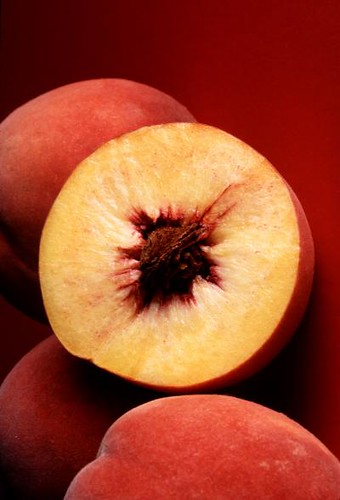This post is part of the Science Tuesday feature series on the USDA blog. Check back each week as we showcase stories and news from the USDA's rich science and research portfolio.By Kathleen Phillips, Texas A&M AgriLife CommunicationsA fresh, juicy peach makes a good addition to a summer lunch bag or picnic. Warm or chilled, you know you have a good one when you have to chase a stream of peach juice with a napkin.
So my recent visit with food chemist Dr. Luis Cisneros-Zevallos and peach breeder Dr. David Byrne was bound to conjure notions of hand-cranked peach ice cream or fresh slices topped with heavy cream.
Turns out, the Texas AgriLife Research scientists have an even better use: to cure breast cancer, even the most aggressive kind, without hurting healthy cells. That's what they've done in the lab with two phenolic compounds in stone fruits.
What's "phenolic," you ask? The phenols are organic compounds that may affect traits such as aroma, taste or color. The two in this case are chlorogenic and neochlorogenic
Many want to know where to get these compounds, if one can cook the peach or eat it raw, and whether these substances might work on other cancers. None of that is known yet – research like this is often a very long process to make sure it’s safe; so far no human clinical trials have been done...
But what this Texas duo has found is deliciously promising: to kill cancer cells and not healthy cells would make chemotherapy much more tolerable.
Their search began with the discovery that antioxidants and phytonutrients in plums equal or surpass so-called super fruits like blueberries. That called for a check against cancer.
"We chose breast cancer because it's one of the cancers with highest incidence among women. So it is of big concern," Cisneros-Zevallos said.
The National Cancer Institute counted 194,000 new cases and 40,610 deaths from breast cancer in 2009. The World Health Organization reports that breast cancer accounts for 16 percent of the cancer deaths of women globally.
Byrne plans to see how researchers who breed peach and plum varieties can make sure these compounds are bred into new fruit varieties Cisneros-Zevallos will continue testing these compounds in different types of cancer.
The work was supported by the Vegetable and Fruit Improvement Center at Texas A&M University, the U.S. Department of Agriculture and the California Tree Fruit Agreement.

Breast cancer cells -- even the most aggressive type -- died after treatments with
peach and plum extracts in lab tests at Texas AgriLife Research.
